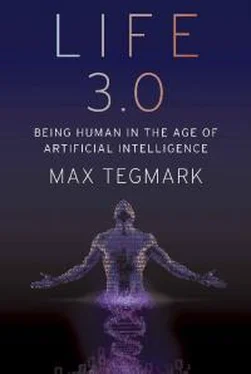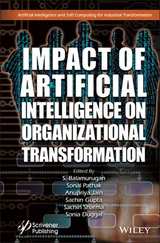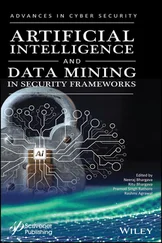They figured that if they could get this recursive self-improvement going, the machine would soon get smart enough that it could also teach itself all other human skills that would be useful.
The First Millions
It was nine o’clock on a Friday morning when they decided to launch. Prometheus was humming away in its custom-built computer cluster, which resided in long rows of racks in a vast, access-controlled, air-conditioned room. For security reasons, it was completely disconnected from the internet, but it contained a local copy of much of the web (Wikipedia, the Library of Congress, Twitter, a selection from YouTube, much of Facebook, etc.) to use as its training data to learn from. *They’d picked this start time to work undisturbed: their families and friends thought they were on a weekend corporate retreat. The kitchenette was loaded with microwaveable food and energy drinks, and they were ready to roll.
When they launched, Prometheus was slightly worse than them at programming AI systems, but made up for this by being vastly faster, spending the equivalent of thousands of person-years chugging away at the problem while they chugged a Red Bull. By 10 a.m., it had completed the first redesign of itself, v2.0, which was slightly better but still subhuman. By the time Prometheus 5.0 launched at 2 p.m., however, the Omegas were awestruck: it had blown their performance benchmarks out of the water, and the rate of progress seemed to be accelerating. By nightfall, they decided to deploy Prometheus 10.0 to start phase 2 of their plan: making money.
Their first target was MTurk, the Amazon Mechanical Turk. After its launch in 2005 as a crowdsourcing internet marketplace, it had grown rapidly, with tens of thousands of people around the world anonymously competing around the clock to perform highly structured chores called HITs, “Human Intelligence Tasks.” These tasks ranged from transcribing audio recordings to classifying images and writing descriptions of web pages, and all had one thing in common: if you did them well, nobody would know that you were an AI. Prometheus 10.0 was able to do about half of the task categories acceptably well. For each such task category, the Omegas had Prometheus design a lean custom-built narrow AI software module that could do precisely such tasks and nothing else. They then uploaded this module to Amazon Web Services, a cloud-computing platform that could run on as many virtual machines as they rented. For every dollar they paid to Amazon’s cloud-computing division, they earned more than two dollars from Amazon’s MTurk division. Little did Amazon suspect that such an amazing arbitrage opportunity existed within their own company!
To cover their tracks, they had discreetly created thousands of MTurk accounts during the preceding months in the names of fictitious people, and the Prometheus-built modules now assumed their identities. The MTurk customers typically paid after about eight hours, at which point the Omegas reinvested the money in more cloud-computing time, using still better task modules made by the latest version of the ever-improving Prometheus. Because they were able to double their money every eight hours, they soon started saturating MTurk’s task supply, and found that they couldn’t earn more than about a million dollars per day without drawing unwanted attention to themselves. But this was more than enough to fund their next step, eliminating any need for awkward cash requests to the chief financial officer.
Dangerous Games
Aside from their AI breakthroughs, one of the recent projects that the Omegas had had the most fun with was planning how to make money as rapidly as possible after Prometheus’ launch. Essentially the whole digital economy was up for grabs, but was it better to start by making computer games, music, movies or software, to write books or articles, to trade on the stock market or to make inventions and sell them? It simply boiled down to maximizing their rate of return on investment, but normal investment strategies were a slow-motion parody of what they could do: whereas a normal investor might be pleased with a 9% return per year, their MTurk investments had yielded 9% per hour, generating eight times more money each day. So now that they’d saturated MTurk, what next?
Their first thought had been to make a killing on the stock market—after all, pretty much all of them had at some point declined a lucrative job offer to develop AI for hedge funds, which were investing heavily in exactly this idea. Some remembered that this was how the AI made its first millions in the movie Transcendence . But the new regulations on derivatives after last year’s crash had limited their options. They soon realized that, even though they could get much better returns than other investors, they’d be unlikely to get returns anywhere close to what they could get from selling their own products. When you have the world’s first superintelligent AI working for you, you’re better off investing in your own companies than in those of others! Although there might be occasional exceptions (such as using Prometheus’ superhuman hacking abilities to get inside information and then buy call options on stocks about to surge), the Omegas felt that this wasn’t worth the unwanted attention it might draw.
When they shifted their focus toward products that they could develop and sell, computer games first seemed the obvious top choice. Prometheus could rapidly become extremely skilled at designing appealing games, easily handling the coding, graphic design, ray tracing of images and all other tasks needed to produce a final ready-to-ship product. Moreover, after digesting all the web’s data on people’s preferences, it would know exactly what each category of gamer liked, and could develop a superhuman ability to optimize a game for sales revenue. The Elder Scrolls V: Skyrim , a game on which many of the Omegas had wasted more hours than they cared to admit, had grossed over $400 million during its first week back in 2011, and they were confident that Prometheus could make something at least this addictive in twenty-four hours using $1 million of cloud-computing resources. They could then sell it online and use Prometheus to impersonate humans talking up the game in the blogosphere. If this brought in $250 million in a week, they would have doubled their investment eight times in eight days, giving a return of 3% per hour—slightly worse than their MTurk start, but much more sustainable. By developing a suite of other games each day, they figured they’d be able to earn $10 billion before long, without coming close to saturating the games market.
But a cybersecurity specialist on their team talked them out of this game plan. She pointed out that it would pose an unacceptable risk of Prometheus breaking out and seizing control of its own destiny. Because they weren’t sure how its goals would evolve during its recursive self-improvement, they had decided to play it safe and go to great lengths to keep Prometheus confined (“boxed”) in ways such that it couldn’t escape onto the internet. For the main Prometheus engine running in their server room, they used physical confinement: there simply was no internet connection, and the only output from Prometheus was in the form of messages and documents it sent to a computer that the Omegas controlled.
On an internet-connected computer, on the other hand, running any complicated program created by Prometheus was a risky proposition: since the Omegas had no way of fully understanding what it would do, they had no way of knowing that it wouldn’t, say, start virally spreading itself online. When testing the software that Prometheus had written for MTurk tasks, the Omegas guarded against this by running it only inside a virtual machine. This is a program that simulates a computer: for example, many Mac users buy virtual machine software that lets them run Windows programs by tricking them into thinking that they’re actually in a Windows machine. The Omegas had created their own virtual machine, nicknamed Pandora’s Box, which simulated an ultrasimplified machine stripped of all bells and whistles that we usually associate with computers: no keyboard, no monitor, no loudspeakers, no internet connectivity, nothing. For the MTurk audio transcriptions, the Omegas set things up so that all that could go into Pandora’s Box was one single audio file and all that could come out was one single text document—the transcription. These laws of the box were to the software inside like the laws of physics are to us inside our Universe: the software couldn’t travel out of the box any more than we can travel faster than the speed of light, no matter how smart we are. Except for that single input and output, the software inside Pandora’s Box was effectively trapped in a parallel universe with its own computational rules. The Omegas had such strong breakout paranoia that they added boxing in time as well, limiting the life span of untrusted code. For example, each time the boxed transcription software had finished transcribing one audio file, the entire memory content of Pandora’s Box was automatically erased and the program was reinstalled from scratch. This way, when it started the next transcription task, it had no knowledge of what had previously happened, and thus no ability to learn over time.
Читать дальше












